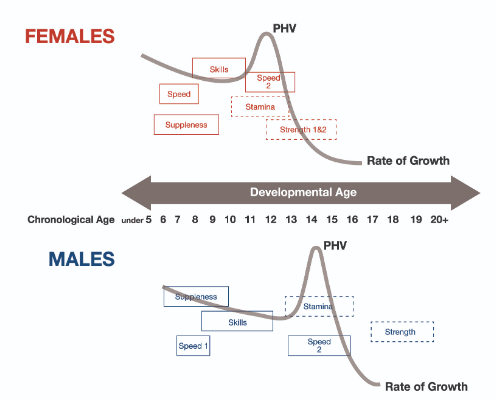GROWING PAINS: INJURY RISK ASSOCIATED W/ GROWTH SPURTS & MATURATION
Reducing injury risk in sports at all levels is a top priority for those who work in Sports Performance and Sports Med. Knowing that past injury is one of the biggest predictors of injury/re-injury, a mismanagement of the training process at the youth level can potentially lead to nagging long-term effects.
As we know and can appreciate, injuries are multifactorial and there’s no one singular reason for an injury incidence. That said, mismanagement of factors like sleep, training load, competition to development ratios, etc. can either increase or decrease the injury risk. One variable in recent years that has come to the forefront of the injury risk paradigm at the youth level is the role that growth spurts and maturation plays regarding injury risk.
In this article we will explain the growth and maturation process and its various stages, how to monitor and identify stages of heightened injury risk and give recommendations on sport/training mortifications during these periods of time.
The Growth & Maturation Process
Growth and maturation is a complex process that is a part of every child’s development. One major landmark during a child’s maturation process is Peak Height Velocity (PHV), which is simply the time in which their growth rate is at its most rapid. There are 3 stages associated with PHV that should be taken into consideration:
Pre-PHV: Defined as when a child is between 70-85% of their Predicted Adult Stature
Circa-PHV: Defined as when a child is between 85-95% of their Predicted Adult Stature
Post-PHV: Defined as when a child is at 95%+ of their Predicted Adult Stature
PHV happens on average in females at approximately age 11 and in males at approximately age 13, but like with anything there is individual variation. Due to this individual variance in Pubertal Timing, not all will experience their PHV growth spurt at these respective ages, with a typical range of +/- 2 years. This means that females could experience their PHV between 9-13y/o and males between 11-15y/o. These ranges are a great demonstration that chronological age alone is not an adequate predictor of maturation status. The total duration of PHV can last up to .5-1yr… because of this and its relationship with injury risk it can be extremely valuable to measure/track.
Monitoring & Identifying Stages of Heightened Injury Risk
Now that we’ve developed a baseline understanding of Peak Height Velocity (PHV) lets assess how to practically measure and track PHV. One of the most practical and efficient ways to measure PHV is using the Khamis & Roche (Prediction of Adult Stature) Method. This method has great utility as a field test with a median error of only 0.8-2.8cm, or less than 1.2inches in the majority of athletes. Getting this data point is the first step to being able to monitor PHV in your athlete.
To calculate your athlete’s Predicted Adult Stature (PAS) using the Khamis & Roche Method you will need a few pieces of information:
Child’s: Sex, Age, Height & Weight
Mother’s: Height
Father’s: Height
The Khamis & Roche Method for PAS is a relatively extensive equation so using the calculator in the link below will quickly give you our athlete’s PAS.
Once we’ve calculated an athlete's PAS we can then take their current height as a percentage of that to determine whether they’re Pre, Circa or Post PHV referencing the table below.
So what does this have to do with heightened injury risk?
A recent 2019 study followed 76 talented youth soccer athletes playing within a premier league club. They determined each athlete's PAS and monitored their PHV over the course of 2 full seasons, while tracking injury rates along the way. What did they find? Athletes who were in Circa-PHV (85-95% PAS) were between 1.5-2.1 times more likely to experience an injury incidence per 1000hrs of exposure compared to athletes that were either Pre-PHV or Post-PHV. There has also been similar research done in 2017 study assessing the role of “bio-banding” in youth sports that has found comparable outcomes.
Sport/Training Modifications & Recommendations
Now having an appreciation of the growth and maturation process, and subsequent injury risks associated with Circa-PHV vs Pre/Post-PHV the next question is… what are recommendations for activity modification during this period? Below you will find a list of activity modification recommendations for during Circa-PHV:
Decrease your athlete’s frequency of competition exposure
Decrease your athlete’s high force/velocity acceleration, deceleration and change of direction exposure
Decrease your athlete’s high intensity jumping/plyometric exposure
Increase your athlete’s movement skills and drills exposure
Increase your athlete's mobility/stability/Core drill exposure
Increase your athlete’s lower intensity, higher volume lifting exposure
Increase your athlete’s nutrition, sleep and recovery exposure
Being mindful of whether your athlete is in Pre, Circa or Post PHV and making appropriate activity modifications can pay off greatly both in the long and short term. At EForce, we take these factors into consideration when developing each athlete's individual training program. If you’re looking for a training program that takes into account your athlete’s individual needs, look no further than EForce Performance!!
Erik Jernstrom
Director of Sports Performance @ EForce
https://sci-hub.se/downloads/2019-07-18/d9/10.1080@17461391.2019.1633416.pdf





